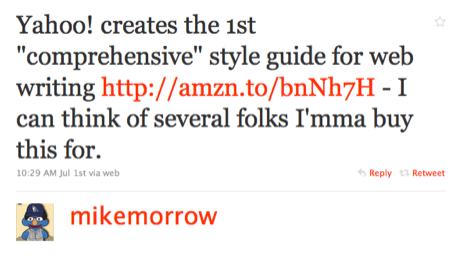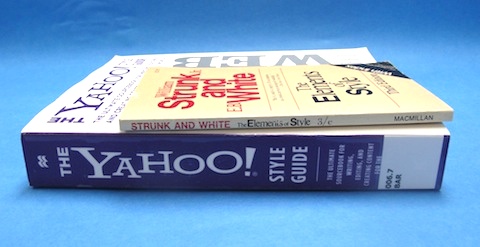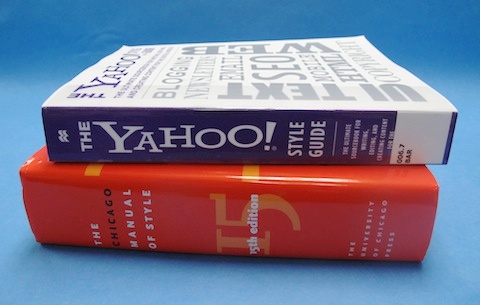The Yahoo! Style Guide
August 2, 2010 at 9:27 AM by Dr. Drang
I first heard about The Yahoo! Style Guide in this tweet from mikemorrow:

I went to my library’s web site, looked it up, and put a hold on it. The book wasn’t in the yet, but it had been ordered and was in the system. No one else had put a hold on it yet, so I’d have it as soon it arrived.1. Here are my impressions of the Guide after a few days of reading bits and pieces.
First, the book is a lot bigger than I was expecting—about 500 pages. Here’s the table of contents:
I-WRITE FOR AN ONLINE AUDIENCE
1. Write for the Web
2. Identify Your Audience
3. Define Your Voice
4. Construct Clear, Compelling Copy
II-SPEAK TO YOUR ENTIRE AUDIENCE
5. Be Inclusive, Write for the World
6. Make Your Site Accessible to Everyone
III-WRITE UI TEXT, EMAIL, AND MOBILE-FRIENDLY CONTENT
7. Write Clear User-Interface Text
8. Write Engaging Email and Newsletters
9. Streamline Text for Mobile Devices
IV-MANAGE THE MECHANICS
10. Punctuate Proficiently
11. Treat Abbreviations, Capitalization, and Titles Consistently
12. Apply a Consistent Style for Numbers
V-CLEAN UP YOUR COPY
13. Shorten and Strengthen Sentences
14. Avoid Common Pitfalls in Word Choice, Grammar, and Spelling
15. Proofread and Test Before You Publish
VI-RESOURCES
16. Get Familiar with Basic Webpage Coding
17. Optimize Your Site for Search Engines
18. Understand the Basics of U.S. Law for Online Content
19. Keep a Word List
Exercise Answer Keys
Acknowledgments
Notes
Selected Bibliography
Index
It’s quite wide ranging.
Parts I and V will probably remind most readers of Strunk and White’s The Elements of Style, except, of course, for the bulk.

Chapter 13 even has a section entitled “Replace superfluous phrases,” an obvious echo of Strunk’s original “Omit needless words.”
I’m tempted to say that if the Guide’s authors had followed their own advice, Parts I and V would have been boiled down to a single directive: Make it shorter. That’s unfair, though, because the Guide does give specific guidance on how to trim words and phrases without losing essential detail. And they back up their arguments for shorter copy with the results of user and eye-tracking studies.
Although the authors clearly favor short copy, they aren’t dogmatic about it. In Chapter 7, on user-interface instructions, they show how instructions on web sites—the parts that tell you how to use the site—are often too short, and are unclear because of their brevity.
I found all of Part III interesting. While there was nothing earthshattering in its recommendations, it covered areas—instructions, email, text messages—that just aren’t in traditional style guides. And the advice just seems right. Of course I shouldn’t be using capitalization alone to identify buttons and menus.
Part IV reminded of the sections in The Chicago Manual of Style that I refer to most often. Here, the comparison of bulk seems to favor the Yahoo! Guide.

To me, Part IV is just too short to be useful. It gives good rules for common situations; but it’s the uncommon situations that make me reach for a style guide, and that’s when a comprehensive reference like the Chicago Manual is invaluable.2 There’s nothing in the Yahoo! Guide that compares to the Chicago Manual’s level of detail when it comes to numbers (although there is a chapter on numbers in the Guide), scientific terms, or the titles of works.
I really liked Chapters 17 and 19. I’m certainly no expert on search engine optimization, but Chapter 17’s clear discussion of it seemed very practical, with none of the voodoo you see in some descriptions of SEO on the web. And Chapter 19’s advice to keep a word list—in effect, your own style guide for treating words and phrases associated with your business consistently across your site—is both smart and well-described. The inclusion of a large excerpt from the Yahoo! word list, with a brief explanation of each treatment, is a great illustration of the idea.
Is The Yahoo! Style Guide worth buying? I suppose that depends on what you already have in your library. The web-specific chapters in Parts III and VI are definitely worth reading, but I don’t think they make the book worth buying if you own other style guides you’re comfortable with. On the other hand, if you don’t own a style guide, the Yahoo! Guide would be a good choice.
-
I love using the computer to interact with the library. ↩
-
The 16th edition of The Chicago Manual of Style is about to be released and is supposed to include more advice on writing for the web. ↩

